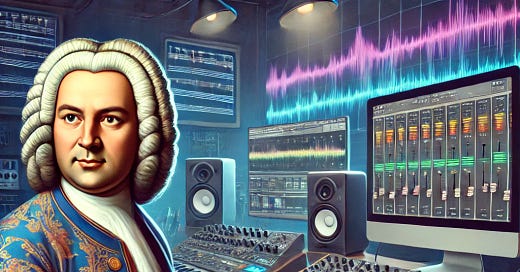Johann Sebastian Bach and the Digital Symphony: The Composer Meets AI and the Modern Musical World
Past Forward: Historical Icons in the Digital Frontier #32
Voice-over provided by Amazon Polly
Also, check out Eleven Labs, which we use for all our fiction.
Preface
Welcome to the thirty-second entry in our ongoing series, "Past Forward: Historical Icons in the Digital Frontier." This series explores how some of history's most remarkable figures might respond if transported into today's world, discovering how their timeless talents and insights could flourish within our modern context. This installment focuses on Johann Sebastian Bach, one of history's greatest composers. Imagine Bach transported into the 21st century, faced with digital music composition, artificial intelligence in music creation, and the incredible evolution of musical instruments. How would the genius behind "The Well-Tempered Clavier" and countless other masterpieces engage with our modern musical world? Let's journey with Bach as he explores digital tools, collaborates with AI, and reimagines his craft in a technological age.
Introduction
A soft melody drifts through the air, fading as Johann Sebastian Bach lifts his hands from the harpsichord in his study. Suddenly, a shimmering glow envelops him, and he finds himself in an unfamiliar room filled not with manuscripts and quills but with computers, synthesizers, and touchscreens. Bach, the master of Baroque composition, has been transported to a 21st-century recording studio, where the tools of creation are a mix of digital interfaces and sleek instruments. The room hums with energy, and Bach, ever curious, steps forward, ready to learn how the art of music has evolved over the past three centuries.
First Impressions: A Modern Studio
Bach takes in his new surroundings with a mix of curiosity and wonder. Gone are the ink-stained manuscripts and candlelit desks; in their place are digital workstations, colorful control boards, and screens glowing with waveforms and musical notations. He approaches a MIDI controller keyboard, intrigued by its minimalist design. Pressing a key, he is startled by the crisp, synthetic sound that emerges, unlike the familiar harpsichord or organ he once played.
A music producer enters the room, recognizing the iconic figure instantly, and begins to guide Bach through the basics of the modern studio. The producer demonstrates how a computer equipped with Digital Audio Workstation (DAW) software can serve as an entire orchestra at one's fingertips. Bach watches in fascination as the producer layers multiple tracks—violins, cellos, flutes—each recorded virtually. He marvels at the efficiency and precision, seeing parallels between his own methodical approach to layering melodies and this new digital technique. The idea that a single person could have such control over every instrument resonates deeply with Bach, and he is eager to explore it further.
Digital Composition: A New Way to Create
Bach is soon introduced to DAW software, where he sees an endless array of possibilities for composing music. He watches as notes are entered on a digital staff, immediately transformed into sound by virtual instruments. Bach finds himself in awe of the vast sonic palette available—everything from baroque strings to electronic synthesizers at his disposal. He begins experimenting, drawing on his love of counterpoint to create new fugues using a combination of traditional instruments and modern sounds.
With the guidance of the producer, Bach begins to understand how electronic music works—how sound waves can be manipulated to create entirely new timbres. He is introduced to synthesizers and drum machines, and although initially perplexed, he soon appreciates their potential. Bach’s natural curiosity drives him to experiment with these new tools, and he finds himself delighting in the endless variety of sounds that can be crafted. He starts to create new compositions that blend baroque structures with modern electronic beats, producing a unique fusion of old and new that captivates the studio audience.
Collaborating with AI: A Creative Partner
Bach’s journey through the modern musical landscape is even more intriguing when he is introduced to artificial intelligence in music composition. The producer shows him an AI tool capable of generating harmonies, composing melodies, and even improvising in various styles. Bach watches as the AI develops a simple theme into a complex, multilayered piece—something reminiscent of his contrapuntal style. He is fascinated to see in AI a partner that can complement his own creativity.
The producer proposes a collaboration: Bach would compose the principal theme, and the AI would develop it further, generating variations and new harmonies. Bach agrees, intrigued by the prospect. He sits down at the MIDI controller and plays a rich, intricate melody full of the expressive nuance for which he was known. The AI takes over, analyzing the theme and then producing variations that surprise even Bach. It modulates keys, shifts rhythms, and introduces harmonies that Bach finds refreshing and innovative.
Bach is impressed by the AI’s ability to adapt and learn from his style. He begins to see artificial intelligence not as a replacement for the human composer but as a collaborator—a tool that can expand the boundaries of what is possible in music. He experiments further, feeding the AI themes from his earlier works and seeing how it reinterprets them in modern styles—sometimes as jazz and other electronic dance music. The result is a fascinating mix of classical structure and contemporary sound, a testament to the timelessness of Bach’s music.
The Evolution of Instruments: A Modern Orchestra
Next, Bach is introduced to the modern orchestra and the evolution of musical instruments. He visits a concert hall where an ensemble is preparing for a performance. To his amazement, the musicians are not limited to traditional strings, winds, and brass. Instead, he sees electric violins, digital keyboards, and hybrid instruments that blend acoustic and electronic elements. The conductor introduces Bach to the electric guitar, which produces a wide range of tones and effects. Bach listens as a guitarist demonstrates the instrument, shifting from gentle melodies to powerful, distorted chords with ease.
Bach is fascinated by the range of expressive possibilities these modern instruments offer. He recalls his own desire to push the boundaries of the harpsichord and organ, and he sees that the spirit of innovation lives on in these new creations. Amplification particularly intrigues him—the ability to make even the softest note resonate throughout an entire concert hall. Bach asks to try an electric violin, and as he plays, he is struck by how seamlessly the instrument can switch between the warmth of an acoustic violin and the experimental tones of electronic effects.
The conductor then introduces Bach to live looping, a modern performance technique that allows a single musician to layer multiple parts in real-time. Bach watches as a violinist uses a looping pedal to build a complex, multilayered piece, much like the fugues he composed in his day. He sees in this technology a reflection of his love for structure and layering, and he eagerly experiments with it, creating loops that weave together themes from his classic compositions with new, improvised elements.
Public Engagement and Musical Education
Bach’s passion for education is reignited as he learns about the ways in which music is taught in the digital age. He visits a music academy where students are learning through a combination of traditional instruction and digital tools. Bach is amazed by the technology available to young musicians: virtual reality platforms that allow students to practice in simulated concert halls, apps that provide instant feedback on intonation and rhythm, and online tutorials that can reach students anywhere in the world.
Bach speaks to the students, sharing stories of his journey as a composer and musician. He talks about the challenges of mastering complex techniques on the harpsichord and organ, and the students are captivated by his dedication. He encourages them to embrace both the old and the new, to learn the foundational skills of music while also exploring the endless possibilities of technology. Bach also emphasizes the importance of discipline, reminding them that while technology can assist in learning, true mastery requires dedication and practice.
In collaboration with the academy’s faculty, Bach begins to develop a new curriculum that combines the study of counterpoint and harmony with digital composition and music production. He believes that the future of music lies in integrating classical principles with modern innovation, and he is eager to help shape the next generation of musicians. The students are inspired by his vision and eagerly begin experimenting with their own compositions, blending Bach’s intricate fugues with modern beats and electronic textures.
A Digital Legacy: Bach in the Modern World
Bach’s journey through the modern musical world culminates in a special concert—a collaboration between Bach, human musicians, and AI. The performance features a mix of Bach’s original compositions, modern reinterpretations, and entirely new works created in partnership with artificial intelligence. The concert is held in a grand concert hall, with a full orchestra, electronic musicians, and AI-generated music filling the space. Bach takes the stage, his hands once accustomed to the harpsichord now resting on a modern digital keyboard.
The audience is spellbound as Bach plays, weaving themes from "The Brandenburg Concertos" with electronic beats and synthesized harmonies. The AI contributes by generating complex, evolving accompaniments, while musicians on electric violins and guitars add layers of expression. The result is a symphony that spans centuries—a fusion of Baroque elegance and modern innovation, of human creativity and artificial intelligence.
As the final note fades, Bach reflects on his journey. He realizes that while the composition tools have changed, the essence of music—the connection between composer, performer, and listener—remains the same. He sees in modern music a continuation of the work he began centuries ago: the pursuit of beauty, complexity, and emotional expression through sound. Bach’s presence in the modern world reminds us that the power of music is timeless, capable of transcending eras and technologies.
Conclusion: The Timeless Composer in a Digital Age
Johann Sebastian Bach’s exploration of the 21st century reveals a world where music has evolved in ways he could never have imagined. From digital composition and AI collaboration to the electrifying evolution of musical instruments, Bach witnesses firsthand how modern technology has shaped his legacy. Yet, through it all, he remains true to the principles that defined his work: a commitment to excellence, a passion for innovation, and an unwavering belief in the power of music to move the human spirit.
As Bach prepares to return to his own time, he leaves behind a message for the musicians of today: "Embrace the tools of your era, but never forget the soul of the music you create. Technology can enhance our abilities, but it is the heart and mind of the musician that truly brings music to life." Johann Sebastian Bach’s journey through the digital age serves as a reminder that while instruments and techniques may change, the essence of music—the expression of the human experience—remains forever timeless.
Thank you for your time today. Until next time, stay gruntled.
Do you like what you read but aren’t yet ready or able to get a paid subscription? Then consider a one-time tip at:
https://www.venmo.com/u/TheCogitatingCeviche
Ko-fi.com/thecogitatingceviche







